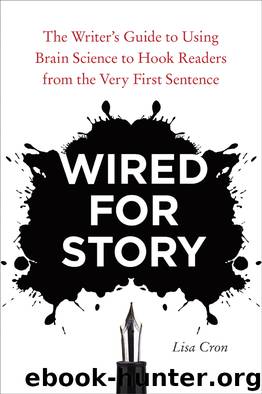Wired for Story: The Writer's Guide to Using Brain Science to Hook Readers from the Very First Sentence by Lisa Cron

Author:Lisa Cron [Cron, Lisa]
Language: eng
Format: epub, mobi, azw3
ISBN: 978-1-60774-246-3
Publisher: Ten Speed Press
Published: 2012-07-09T16:00:00+00:00
Suspense Is the Handmaiden of Conflict
As we know, a story spans the distance from “before” to “after,” when things are in flux. Therefore a story inherently chronicles something that is changing. Usually that “something” revolves around a problem the protagonist must solve in order to actually get from the shores of “before” to the banks of “after.”
On the surface, conflict is borne along by escalating external obstacles that keep the protagonist from quickly solving the problem and getting on with his day, no worse for wear. But those obstacles mean nothing unless, beneath the surface, the seeds of that conflict are present from the outset, as they begin pushing their tender shoots through the soil in search of the sun. Picture it as the first hairline crack in the otherwise solid wall of “before.” The cause of this fissure is often the answer to the question, Why does this story have to start at this very minute? For instance, in Anita Shreve’s The Pilot’s Wife, it’s the ominous sound of a predawn knock at the door that tells Kathryn, the protagonist, that something is very wrong. This initial crack causes the plaster to slowly crumble as Kathryn discovers that her husband, Jack, was in many ways a complete stranger. The story, however, isn’t in the facts of Kathryn’s situation, per se, but in how she struggles to make sense of them, given that everything she believed to be true up to that moment, wasn’t. Talk about the kind of change we’re wired to resist. Everything in Kathryn wants to believe Jack was the perfect husband, if only life (aka the story) would stop poking holes in her carefully—and largely subconsciously—constructed rationalizations.
Thus a story’s first hairline crack and its resulting offshoots are like fault lines, running through the center of the protagonist’s world, undermining everything. As with an earthquake, the cracks tend to be caused by two opposing forces, with the protagonist caught between them. I like to think of these battling forces as “the versus,” which taken together create the arena in which the story then proceeds to duke it out. Keeping in mind that every story has more than one versus, here are the most common:
• What the protagonist believes is true versus what is actually true
• What the protagonist wants versus what the protagonist actually has
• What the protagonist wants versus what’s expected of her
• The protagonist versus herself
• The protagonist’s inner goal versus the protagonist’s external goal
• The protagonist’s fear versus the protagonist’s goal (external, internal, or both)
• The protagonist versus the antagonist
• The antagonist versus mercy (or the appearance thereof)
Download
Wired for Story: The Writer's Guide to Using Brain Science to Hook Readers from the Very First Sentence by Lisa Cron.mobi
Wired for Story: The Writer's Guide to Using Brain Science to Hook Readers from the Very First Sentence by Lisa Cron.azw3
This site does not store any files on its server. We only index and link to content provided by other sites. Please contact the content providers to delete copyright contents if any and email us, we'll remove relevant links or contents immediately.
Cecilia; Or, Memoirs of an Heiress — Volume 1 by Fanny Burney(32433)
Cecilia; Or, Memoirs of an Heiress — Volume 2 by Fanny Burney(31866)
Cecilia; Or, Memoirs of an Heiress — Volume 3 by Fanny Burney(31850)
The Lost Art of Listening by Michael P. Nichols(7403)
Asking the Right Questions: A Guide to Critical Thinking by M. Neil Browne & Stuart M. Keeley(5629)
We Need to Talk by Celeste Headlee(5542)
On Writing A Memoir of the Craft by Stephen King(4863)
Dialogue by Robert McKee(4321)
Pre-Suasion: A Revolutionary Way to Influence and Persuade by Robert Cialdini(4142)
I Have Something to Say: Mastering the Art of Public Speaking in an Age of Disconnection by John Bowe(3838)
Elements of Style 2017 by Richard De A'Morelli(3306)
The Book of Human Emotions by Tiffany Watt Smith(3235)
Fluent Forever: How to Learn Any Language Fast and Never Forget It by Gabriel Wyner(3024)
Name Book, The: Over 10,000 Names--Their Meanings, Origins, and Spiritual Significance by Astoria Dorothy(2938)
Good Humor, Bad Taste: A Sociology of the Joke by Kuipers Giselinde(2902)
Why I Write by George Orwell(2874)
The Art Of Deception by Kevin Mitnick(2735)
The Grammaring Guide to English Grammar with Exercises by Péter Simon(2706)
Ancient Worlds by Michael Scott(2622)
